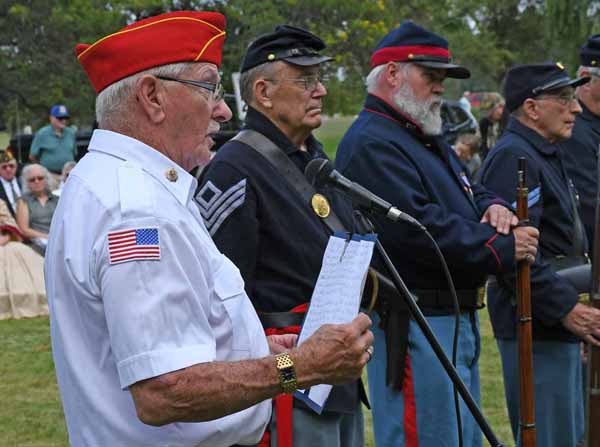Small Maine town rededicates Civil War monument erected in 1931
Gathering at a local cemetery beneath a beautiful late summer sky, residents of Milo, Maine re-dedicated their town’s Civil War monument this month with capable assistance from Civil War descendants and re-enactors.

Patriotism runs deep in Milo, located where the Piscataquis, Pleasant, and Sebec rivers meet in southern Piscataquis County. With 2,250 residents according to the 2020 census, Milo is decidedly rural, an hour by highway from Bangor (the nearest large city) and only a short distance from the almost uninhabited forests flowing away to the Canadian border.
The town had 959 residents in 1860, or so the federal census claimed, and many Milo men went to war; some did not return home. Milo men have served the United States in every war since then, and American and service-branch flags dot many, many graves at Evergreen Cemetery on Park Street (modern Route 11).
The town erected a wooden Civil War memorial in the cemetery in 1889. Thirty-eight years later, members of the Jane Carver Sampson Tent No. 18, Daughters of Union Veterans of the Civil War, started raising funds for a permanent memorial. A large crowd watched as the gray granite shaft was dedicated at the cemetery on May 20, 1931. The Jane Carver Sampson Tent disbanded years later.
In the 21st century, Milo resident and Marine Corps veteran Ronald Knowles spearheaded an effort to create a well-designed Veterans Memorial at the cemetery’s main Park Street entrance. The town moved the Civil War monument (which is owned by the DUVCW) to a prominent location near the street and within the Veterans Memorial a few years ago, and residents decided to re-dedicate the monument during the town’s 2023 bicentennial festivities.

The ceremony started at 2 p.m., Saturday, August 12. Participating organizations included the Milo Historical Society; the Sarah Elizabeth Palmer Tent No. 23, DUVCW; the Col. C. S. Douty Camp No. 11, Sons of Union Veterans of the Civil War; re-enactors from Co. B, 20th Maine Infantry Regiment; and the Marine Corps League.
Representing the town, Milo Select Board Chair Don Banker invited Peter Redman, Department of Maine Commander, SUVCW, “to accept … this memorial and to request that it be re-dedicated by you to the noble purpose for which it has been set up.”
Responding for the SUVCW “and its allied orders representing as they do all the soldiers and sailors who defended the integrity and authority of the nation,” Redman said, “I thank you and those [that] you represent for this memorial,” which “assures us that those who gave their lives for the Union … are held in remembrance.
“It stands for brave and loyal obedience to the command of the nation,” he said. The monument “gives encouragement for the future since the recognition and approval of it gives a patriotic fidelity, heroism, and incentive for the display of public valor and virtue in all coming time.”

Color guards from Col. C. S. Douty Camp No. 11 and Co. B, 20th Maine Infantry posted the colors, and an SUVCW member read aloud the names of Milo men who died in military service during the war.
As SUVCW Chaplain Howard Black started to read the prayer of dedication, a siren sounded in the distance, then intensified as a sheriff’s patrol cruiser raced north on Park Street. “Almighty God, we thank you for your sovereign care and protection,” Black said.
The cruiser’s driver silenced the siren while passing the ceremony. “May our dead be enshrined in our hearts, may their graves be altars of our grateful and reverential patriotism,” Black said as the siren resumed in the distance.
” And now, O God, bless this memorial … in honor of the mothers who gave their sons to brave deeds, in honor of wives who wept for husbands who shall never come back again, in honor of children whose heritage is their fallen father’s heroic name, in honor of men and women who ministered to the hurt and dying,” Black said.
Estella Bennett, the DUVCW’s Department of Maine president, recalled the purpose of the organization and the veteran-oriented services that its members provide. She belongs to the Sarah Elizabeth Palmer Tent, which formed in June 2004.

“The cause is great,” said Ronald Knowles, quoting “a Maine youngster” who had joined “the fight to save the Union and end slavery.” He cited Maine’s contributions to the war, including more than 70,000 soldiers, more than 40 state-raised army units, and 7,322 Mainers who died in military service.
The Co. B color guard fired a three-volley salute, and a trumpeter played Taps. Redman thanked Banker “and those you represent for the courtesy in permitting us … to honor our dead.”
Black gave the benediction. “We assign back to the town of Milo this memorial, and I thank you for permitting us this opportunity,” he said. The color guards then retired the colors.
A video of the monument re-dedication ceremony can be viewed on my YouTube channel.
What a coincidence. My hometown, San Antonio, Texas, also used to have a Confederate memorial. It depicted no general. It praised no Confederate leader. It simply reminded the viewer: “Lest we Forget Our Confederate Dead.” It did depict the common Confederate soldier. The artist who designed the statue of the soldier was an artist in New Orleans. Later in her life, she painted “Negroes” in their daily life – an uncommon subject for New Orleans art in the 1930’s. That same artist, Julia Montgomery, wrote an article for the major New Orleans paper extolling the life of a woman who chose not to marry. Julia was a woman ahead of her time. Julia’s father, Capt. John Montgomery joined the war late – in 1863. But, like so many, he came home “broken” in body and spirit. He died within 5 years of the war. Yet, that memorial, Julia’s memorial, was accused of racist intent and pulled down.
Tom
Too bad.